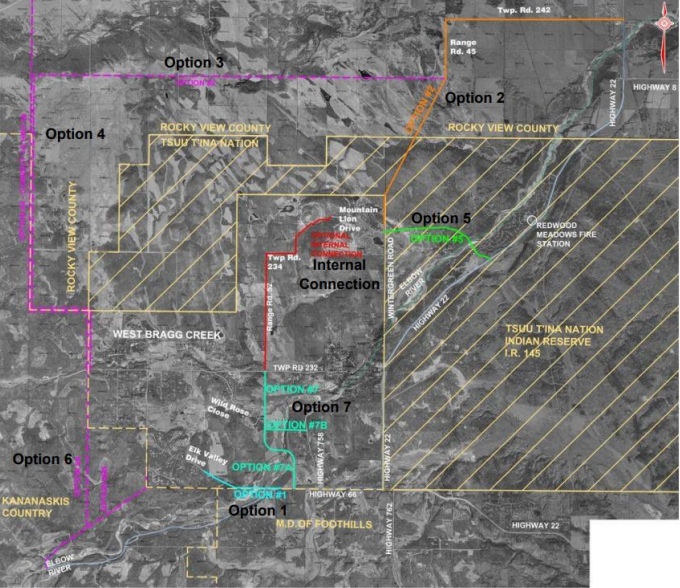Rocky View County (RVC) moved during its Sept. 12 Governance Committee meeting to close the loop on any future conversations with Tsuut’ina First Nation on a potential emergency exit road through the its lands in the event of a fire or flood emergency in West Bragg Creek.
The County will instead turn its attentions elsewhere to find a viable secondary access route.
According to RVC staff, there have been no further conversations about a potential secondary access route through Tsuut’ina lands in at least three years.
“There were presentations that we made to the Nation’s council to articulate emergency access– the need and the benefit,” explained RVC Acting CAO Byron Riemann. “There were a couple of conversations back in the day with a different council. There was a joint understanding of potentially going together to try to acquire some funding to help facilitate the construction of this road, but, unfortunately, none of those ever materialized.”
Reimann said from RVC staff’s point of view it wasn’t about the lack of desire to hold further conversations with the First Nation, but rather a matter of even getting somebody on the phone to advance any sort of conversation in the first place.
“We sit today with no conversation left behind,” he told the Governance Committee.
That being said, Reimann left it up to consultant Shane Duval of Tetra Tech to lay out other potential options for committee members.
Referencing the previous “West Bragg Creek Emergency Access Study” conducted by Tetra Tech in 2017, Duval said the most viable options now appeared to be “Option 7B,” to the south with a full bridge construction crossing the Elbow River south from Township Road 232 along Range Road 52 running toward Highway 758 through connecting through Bragg Creek Provincial Park lands.
Or alternatively, instead of a full bridge, rather a sturdy 2.5 meter wide pedestrian one lane bridge capable of holding the weight of a fully loaded fire vehicle across either east across the Elbow River to Spruce Avenue or south from Bracken Road across the Elbow to Highway 758, in the event of an emergency.
With the 7B full bridge option, Duval explained, the estimated cost to create the bridge and prepare the route would be around $40 million. The pedestrian bridge options would be considerably cheaper, at an estimated cost of $8.1 million.
Duval acknowledged during Tetra Tech’s consultations with the community in preparing the 2017 study of potential locations for a West Bragg Creek secondary access the southern route through the provincial park seemed to be the least preferred, despite it making the most sense from an engineering perspective.
“The risk associated with options 7A and 7B were community and social impacts that were extremely expressed at the open houses when we were discussing those with residents,” he told the Governance Committee on Sept. 12. “It should be noted, (however), that the 7B option was utilizing an existing road corridor on the south boundary of the provincial park. So it seemed reasonable that this access location would be viable without having to purchase lands unless it is included as part of the park.”
Duval explained that the residents of the Wildrose area, in particular, were heavily opposed to Option 7B, and a potential bridge crossing at Elbow River nearby. Past community opposition, he explained, would warrant a further feasibility study commissioned by RVC to explore all the pros and cons of each option in more detail.
“In addition to the potential community opposition, further detailed assessment is required to compare the crossing at Bracken Road or Spruce Avenue to ensure the constructability and integration into the overall active transportation network for Bragg Creek,” Duval stated in his submissions to the Governance Committee.
Division 3 Coun. and Reeve Crystal Kissel was not sold on the idea of preferring these options over potentially attempting to re-open conversations with Tsuu’tina First Nation on a route through the Nation’s lands once again.
“I think that conversation needs to go back to the Tsuut’ina first,” she said. “I think there is a lot of moving parts that happened with SR-1 and everything going on, and I think that conversation should be had first.”
Division 1 Coun. Kevin Hanson said a lot had changed in Bragg Creek since the 2017 study, which encapsulated a lot of objections to the southern egress route at that time.
“I think public perception of the hamlet is probably a little different now that mitigation is finished,” he explained. “Potentially traffic along the berms is now a thing that they want to do– as opposed to perhaps being worried about all the pedestrians.”
Hanson then put forth a motion that the Governance Committee should direct administration to prepare a report for Rocky View County council’s consideration to complete the feasibility assessment for Option 7B, and for the Bracken Road and Spruce Avenue bridge crossings.
Hanson’s motion was approved by his committee colleagues by a vote of 4-2, with Kissel and Division 2 Coun. and committee Chair Don Kochan opposed. Division 7 Coun. Al Schule was not present for the meeting.



